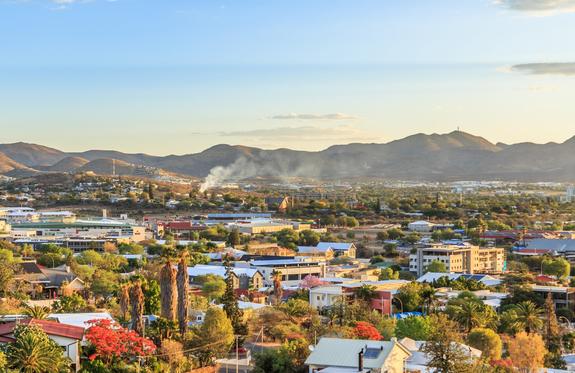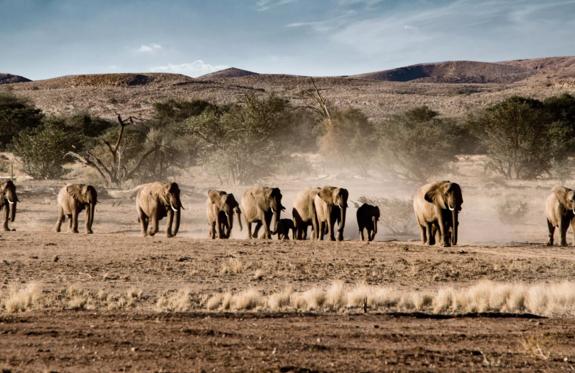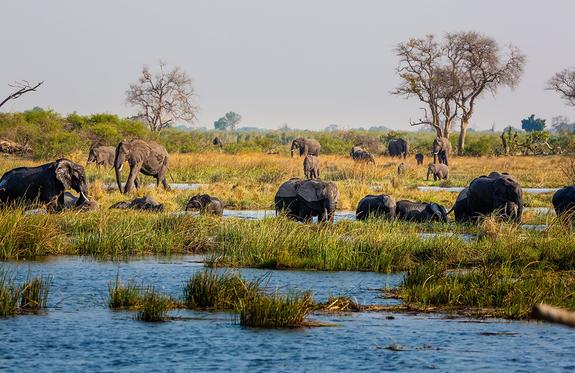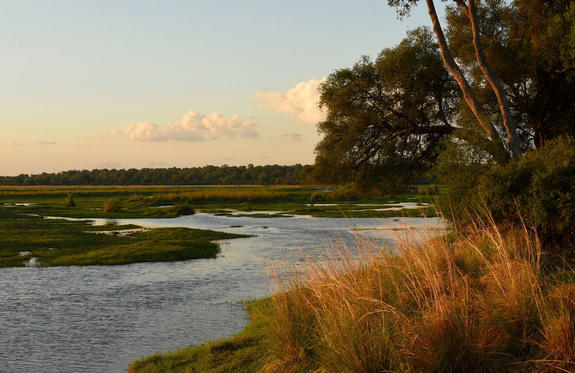Located in southwestern Africa, Namibia boasts a well-developed infrastructure, some of the best tourist facilities in Africa, and an impressive list of breathtaking natural wonders. Visitors can explore the capital of Windhoek and discover the lovely coastal town of Swakopmund boasting remnants of the country’s German influence, reflected in the architecture, culture, cuisine and the annual Oktoberfest celebrations. To properly appreciate this extraordinary country, you will have to venture out of the cities to explore the remarkable natural landscapes Namibia has to offer. These include: the impressive Fish River Canyon; the vast Etosha National Park teeming with abundant wildlife, such as lions, desert-adapted elephants and the Hartmann's Mountain Zebra; the hauntingly beautiful Kalahari Desert; and of course the Namib Desert stretching for over 2000 km along the magnificent Atlantic Coast. Namibia is an ideal destination for travellers seeking an unforgettable African experience in a uniquely beautiful untamed wilderness.

The Okonjima Nature Reserve is a renowned wildlife sanctuary in Namibia, located in the central region of the country, approximately halfway between the capital, Windhoek, and Etosha National Park. Covering an area of about 200 square kilometers, the reserve is privately managed.
Okonjima is famous for its conservation efforts, particularly for the preservation and rehabilitation of cheetahs and leopards. It serves as the headquarters of the AfriCat Foundation, a non-profit organization dedicated to the conservation and protection of these big cats. The foundation conducts research, provides veterinary care, and runs educational programs to raise awareness about the importance of predator conservation.
In addition to cheetahs and leopards, Okonjima is home to other wildlife species such as spotted hyenas, giraffes, zebras, antelopes, and various bird species. The reserve offers a diverse ecosystem of open grasslands, rocky hills, and dense bushland, providing a suitable habitat for these animals.
Besides wildlife-focused activities, the Okonjima Nature Reserve also offers opportunities for cultural interactions and outdoor adventures. Visitors can learn about the local Herero and Himba cultures through village visits and craft markets. Hiking trails, bird watching, and visits to the Bushman Trail Museum allow guests to explore the natural and cultural heritage of the reserve.
Overall, the Okonjima Nature Reserve in Namibia is a remarkable destination, offering wildlife enthusiasts the chance to experience the beauty of cheetahs and leopards in their natural environment while supporting conservation efforts. It is a unique blend of luxury, adventure, and education, making it an ideal choice for nature lovers.

Windhoek is the capital of Namibia, located in the central highlands of the country. South of the city, the sprawling Heroes' Acre war memorial commemorates Namibia's independence in 1990. On a hill in the city center stands the Old Fort, dating back to the 1890s, which was a former military headquarters with historical exhibits, and the Independence Memorial Museum. Colonial influences are visible in nearby buildings such as the Lutheran Christ Church made of sandstone, as well as in the Victorian buildings lining the streets of Windhoek.
THINGS TO DO
- National Museum Namibia (www.museums.com.na/museums/ windhoek/national-museum-of-namibia)
- Independence Memorial Museums (www.museumscom.na/ museums/wind-hoek/independence-museum)
- Visit the Christ Church
- Tour through the Katutura Township (www.mwiyatours.com)
UNSERE RESTAURANT TIPPS
- Joe's Beerhouse (www.joesbeerhouse.com)
- Daisho Sushibar (www.daishosushibar.com/menu)
- ButcherBlock (www.butcherblocksteakhouse.com)
- Leo’s at the Castle (www.heinitzburg.com)
TIPS
Stellenbosch Wine Bar & Bistro: The bistro-style menu showcases the fresh and diverse flavors of Namibia. The focus is on prime Namibian cuts of meat, perfectly grilled over an open flame, accompanied by a selection of delicious homemade sauces and sides. Complete your meal with a quality wine from the excellent wine list.
Tel.: +264 61 309 141 \ Web.: www.thestellenboschwinebar.com

Located just south of the boundary of Etosha National Park in northwestern Namibia, Etosha South makes up the southern region of this wild paradise. The area is comprised of a collection of world class private game reserves. The national park can be accessed via the southern entrance at Andersson’s Gate. Visitors can catch a glimpse of a variety of wildlife including: lion, giraffe, elephant, white and black rhino, and a multitude of plains game. Popular activities include: enjoying an open 4x4 safari with an expert guide, half day or full day drives with the option of a picnic lunch with wine on the full day game drive.

The Etosha National Park is a true paradise for wildlife enthusiasts. Covering an area of approximately 22,000 square kilometers, the park is home to an impressive variety of wildlife. Its main attraction, the Etosha Pan, is an expansive salt pan that offers a unique and fascinating landscape, making it a renowned spot for wildlife observation. Visitors to the Etosha National Park have the privilege of experiencing a wide range of animals in their natural habitat. Here is a list of the most commonly found species in the park:
Elephants | Lions | Black Rhinoceros | White Rhinoceros | Giraffes | Zebras | Oryx | Wildebeests | Impalas | Leopards | Cheetahs | Hyenas | Jackals | Flamingos | Springboks | Hartebeests | Kudus | Pelicans | Hornbills | Eagles | Vultures
These animals roam through savannah-like landscapes, visit waterholes, and provide an impressive spectacle in the Etosha National Park. Herds of elephants pass by, lions rest in the shade, and zebras and giraffes graze. The park offers endless opportunities to observe wildlife in their natural environment. Bird enthusiasts will also be thrilled by the diversity of birdlife, from majestic raptors like eagles and vultures to colorful flamingos in the vast Etosha Pan.
GATES OF THE ETOSHA NATIONAL
There are several entrance gates to the Etosha National Park. In the east lies the Andersson Gate, and in the west, the Galton Gate, named after the explorers Charles Andersson and Francis Galton. The Von Lindequist Gate in the east was named after the governor of German South West Africa, who declared Etosha a protected area in 1907. The Nehale Lya Mpingana Gate near the Andoni Plains is named after a king of the former Ovambo country.
Etosha Trading Post (Southern Entrance Etosha NP): As the name "Trading Post" suggests, the recently opened shop and gas station are places of exchange. The shop offers visitors all the essential groceries, snacks, and souvenirs. The entire building is designed in a historical style, where past and present merge... all located in a strategically perfect location just 10 km from the Andersson Gate, the southern entrance to the national park.

Located in Northwestern Namibia, Etosha East is a protected sanctuary in the eastern part of the world-renowned Etosha National Park, known as one of the most accessible game reserves in Southern Africa. Etosha East boasts vast open plains scattered with semi-arid savannah grasslands dotted with watering holes and secluded bush camps. An impressive 5000-square-kilometre Etosha salt pan makes up a large area of the eastern side of the park and can even be seen from space. This remote area teems with abundant wildlife such as lions, elephants, black rhinos and giraffes, as well as a variety of birdlife featuring flamingos, ostriches, eagles, hornbills, and owls.

Rundu is the capital of the Kavango Province in Namibia. Located in the northern part of the country, it has a population of approximately 90,000 residents. After the capital Windhoek, Rundu is the second-largest city in Namibia and lies in the northeast, directly on the Okavango River and the border with Angola. The city serves as the main center of the Kavango Region, an area characterized by tropical forests and riverine savannas.
Rundu experiences a semi-arid climate with hot summers and mild winters. The city is also known for hosting the largest open market in the area, which attracts many tourists.
THINGS TO DO
Activities in and around Rundu include:
- Fishing and water sports
- Khaudum Game Reserve
- Mangetti National Park
- Okavango River
- Open market
- Woodcarver's market

The Caprivi Strip, also known as the Caprivi Zipfel, is a narrow strip of land in the extreme northeast of Namibia, stretching about 400 kilometers. Germany acquired the territory in 1890 from the British in exchange for Zanzibar, and it was named after the German Chancellor Graf von Caprivi. The once challenging gravel road through the Caprivi was replaced in 2001 by the tarred Caprivi Highway (B8), making it easier to reach popular destinations in the north.
The Caprivi falls within the tropical climate zone with high rainfall during the rainy season (December to March). The region is rich in water, hosting diverse wildlife, including numerous elephants. Reserves like Bwabwata, Mudumu, Lizauli, and Mamili protect wildlife without border fences, allowing animals to roam freely into neighboring countries like Botswana and Zambia. Rundu on the Okavango River serves as the gateway to the Caprivi Strip, offering rich wildlife and plant diversity as well as cultural richness.
Divundu, located at the confluence of the Okavango and Kwando rivers, is known for wildlife sightings, Popa Falls, and the Mahango Game Park. Kwando, a village on the banks of the river of the same name, serves as a starting point for safaris in Mudumu and Mamili National Parks.
The Caprivi Strip, with its towns, offers visitors the opportunity to discover Namibia's natural beauty and wildlife, regardless of their interests in culture, adventure, or relaxation.
TIPS
The Living Museum of the Mafwe opened in 2008 and is a cultural highlight in the Caprivi Strip. In this authentic open-air museum, guests can explore the traditional culture and original way of life of the Mafwe people. The museum consists of a traditional village and the surrounding fields on a hill overlooking the Kwando River. Huge baobab trees provide shade while the Mafwe present their ancient culture in traditional attire. The performers at the Mafwe Living Museum engage with the offered program very interactively with great dedication, and the guide translates into English.

The Kwando River winds its way through the breathtaking southern part of Africa, forming much of the eastern border of Namibia.
The banks of the Kwando River are lined with lush vegetation, harboring a rich variety of plants and trees. This abundant flora not only provides a visual delight but also serves as a habitat for a wealth of wildlife, including elephants, buffaloes, antelopes, and a variety of bird species. The river and its surroundings are part of the Caprivi Strip, a region known for its biodiversity and pristine nature.
Therefore, the riverbanks provide ideal spots for nature lovers and photographers to observe and capture the rich wildlife in their natural habitat. The tranquil atmosphere of the river also creates a unique opportunity for visitors to enjoy the beauty of the landscape and escape the hustle and bustle of everyday life.
The surrounding villages along the Kwando River allow travelers to immerse themselves in the culture of the local population and experience the warm hospitality of the community. The traditional customs and everyday life on the riverbank contribute to the authentic experience that makes the Kwando River an unforgettable destination.

The largest wildlife reserve in the northeastern Namibian Caprivi Strip is the West Caprivi National Park, which was merged with the Mahango Game Reserve in 2007 and is now called the Bwabwata National Park. However, amidst this area dedicated to wildlife and plant protection, approximately 5,500 inhabitants also reside, posing a significant challenge for park management – after all, this entails balancing conservation efforts with human settlement. Covering an area of 6,274 square kilometers, the national park is the second-largest in Namibia.
The Bwabwata National Park is ideal for wildlife safaris due to its lack of fencing, which allows for constant wildlife movement and numerous opportunities to observe various species in their natural habitat.
In the Bwabwata National Park, you can encounter Namibia's last wild dogs, hippos, crocodiles, and numerous water birds. Some members of the "Big Five" are frequently spotted along the riverbanks: lions, elephants, buffaloes, and leopards – only rhinos are not found here. Instead, expect to encounter roan and sable antelopes, bushbucks, wildebeests, impalas, kudus, oryxes, elands, red lechwes, reedbucks, sitatungas, as well as smaller antelope and mammal species, which you can discover while they search for water.
Situated in the southern reaches of Africa, Botswana is renowned for its pristine wilderness areas characterised by deep lagoons, wetlands, lush palms, rugged hills and desert plains. The country’s primary tourist drawcard is undoubtedly the vast red expanse of the Kalahari Desert and its remarkably beautiful Okavango Delta, the largest inland delta in the world. These natural wonders provide a tranquil haven for an abundance of African wildlife to thrive. Other highlights include the impressive Makgadikgadi Salt Pans, where visitors are privy to massive zebra migrations during the flood season; the Savuti plains, which host a significant pride of lions; and the Tsodilo Hills, where 4500 rock paintings form a unique record of human settlement over many millennia.

Kasane is located in northeastern Botswana, on the banks of the Chobe River and near the borders with Zimbabwe and Zambia. The town serves as a convenient base for safaris, boat trips, and excursions to the Victoria Falls.
The Chobe River attracts large herds of wildlife, including elephants, buffalo, hippos, and crocodiles, especially during the dry season from May to October. The wet season from November to March brings lush greenery and excellent opportunities for birdwatching.
Activities & Highlights:
Game drives in Chobe National Park
Boat safaris on the Chobe River
Day trips to Victoria Falls
Birdwatching and cultural visits
Kasane is the perfect starting point for unforgettable safari adventures and nature experiences in Botswana.

Chobe National Park is situated in the far northeast of Botswana, bordered to the north by the mighty Chobe River. It is the second-largest national park in Botswana and features four distinct ecosystems: the Savuti Channel in the west; the Linyanti Swamps in the northwest; the arid hinterland in between and Serondela in the extreme northeast with fertile plains and thick forests. This diversity of habitats provides a sanctuary to an astonishing array of African wildlife, most notably the impressive, shifting migratory population of more than 50 000 elephants. Visitors are also likely to spot lions, leopards, hyenas, wild dogs, impala, waterbuck, kudu, zebra, wildebeest, giraffes, and warthog. The park is also famous for its wonderful riverboat safaris, making Chobe an essential destination for any avid safari enthusiast.
A nation of spectacular natural beauty, friendly people and rich culture, Zimbabwe’s status as one of Africa’s leading safari destinations was dampened for years by its political instability. But now that the country is transcending its strife and returning to a state of equilibrium, it is once again emerging as a vacation highlight of the continent. Victoria Falls – known to locals as ‘The Smoke That Thunders’ – is one of the seven natural wonders of the world and the sheer power of this massive body of water plunging into the Zambezi Gorge is awe-inspiring and unforgettable. Lake Kariba, with its game-rich shores and islands, is an idyllic safari spot featuring mind-blowing sunsets; Hwange National Park is known for its huge herds of elephants; and a kayak trip down the Zambezi through the Mana Pools National Park will appeal to the intrepid traveller, providing close encounters with crocodiles, hippos and a host of other wildlife.

The Victoria Falls are one of the natural wonders of the world - the masses of water thunderously plunge into the gorge, creating a spray that forms the so-called rainforest. As the sunlight penetrates, a breathtaking rainbow forms over the falls. Livingstone is situated on the Zambian side, while Victoria Falls, the city named after the falls, is on the Zimbabwean side. Both locations provide access to witness the majestic falls.
GOOD TO KNOW
"The Smoke That Thunders": The powerful curtain of water is known to the locals as Mosi-oa-Tunya, or "The Smoke That Thunders." The Scottish explorer David Livingstone discovered these millions of years old waterfalls in 1855 during one of his journeys to the East Coast of Africa. Traveling south from Luanda to Sesheke, he encountered the picturesque falls and named them after the British monarch, Queen Victoria. Livingstone was guided to the falls by the Makalolo tribe. When Livingstone's reports reached neighboring countries, British traders were the first to journey to the falls. A trading post was established on the riverbank, laying the initial foundations for the present-day city of Victoria Falls, known as Old Drift at that time.
"Dr Livingstone, I presume?": In the 14 years following the discovery of the Victoria Falls, Livingstone struggled with the health consequences of his journey. Isolating himself from the outside world for years raised concerns about his well-being, prompting Henry Stanley to be sent to find him. Stanley reached his destination on November 10, 1871, in an African village, greeting Livingstone with the famous words, "Dr Livingstone, I presume?" This marked the beginning of a close friendship that ended with Stanley's return to England in 1872, without Livingstone. He could not convince Livingstone to return to his homeland. Dr. David Livingstone passed away on May 1, 1873, at the age of 60. In his lifetime, he covered 50,000 km within Africa, making a significant contribution to the exploration of previously unknown regions.
Livingstone: The small town of Livingstone is situated on the Zambian side of the famous Victoria Falls. The town has approximately 15,000 residents, mostly belonging to the Tonga tribe. In the main street, named "Mosi-oa-Tunya Road" after the waterfalls, classic colonial buildings can still be seen, including Victorian houses with tin roofs. The spectacular Victoria Falls and the equally impressive bridge connecting Zambia and Zimbabwe are about 10 km away from Livingstone. From Livingstone, a variety of safari and leisure activities can be booked.
Victoria Falls Bridge: The Victoria Falls Bridge was built in 1905 to connect present-day Zambia and Zimbabwe. Designed by Sir Ralph Freeman, who also planned the bridge in the Sydney Harbor, the steel arch of the bridge spans 156 meters and rises 128 meters above the gorge. It safely carries cars, trains, and pedestrians between the two countries and is also renowned for the breathtaking 111-meter bungee jump (Shearwater Bungee).
World Heritage: The Victoria Falls were recognized as a World Heritage Site in 1989 - one of the most spectacular waterfalls globally. When the Zambezi River is in flood, the falls create the largest curtain of water in the world. The falls and the surrounding rainforest are protected as a 23.4-square-kilometer national park, one of the four World Heritage Sites in Zimbabwe. Booking the "Flight of Angels" is highly recommended, as the falls are even more breathtaking from a bird's-eye view.
Travel Time: The best time to visit is towards the end of the dry season when the water flow is still impressive, but not overwhelming. During peak water levels, the spray can be so dense that the falls are often challenging to see. The lowest water level is in November/December when less than 20,000 cubic meters of water per minute plunge into the gorge. In contrast, the highest water level, with more than 550,000 cubic meters of water per minute, is in February/April. Between April and May, the falls are most spectacular, although it can be difficult to see them along the entire length from the footpath.
For visiting the falls, an entrance fee is charged. Depending on the amount of spray, it is advisable to rent a raincoat or an umbrella to avoid not only wet feet but also to keep your mobile phone and camera dry. The spray provides a welcome cooling effect in the summer, but do not forget to protect your electronic devices.
THINGS TO DO:
At Victoria Falls, a multitude of activities are offered, including boat rides, bungee jumping, safaris, white-water rafting, helicopter tours, and more – catering to every preference.
- Bungee Jumping from one of the world's highest bridges: On the Zambia-Zimbabwe Bridge between the Vic Falls and Livingstone, you have the opportunity to jump 110 meters into the abyss. Another highlight – the bridge also features the world's longest zip line, allowing you to slide from one end of the gorge to the other.
- Interaction with Elephants: "Elephant Encounter" provides guests with the opportunity to spend time in close proximity to these majestic creatures, forming a natural connection with the elephants in a unique way.
- Boat Tours & Sunset Cruises: Enjoy the expanse and tranquility of the Zambezi River with a refreshing drink as the sun sets. A romantic end to an adventurous day.
- Private Helicopter Flight: A flight over the falls is a must-do. Admiring the falls from a bird's-eye view is an unforgettable experience.
THE ZAMBEZI:
The Zambezi, Africa's fourth-longest river at 2,700 km, flows through six countries from Central Africa to the Indian Ocean, forming the spectacular Victoria Falls and the winding Batoka Gorge. Unlike other rivers, its banks are sparsely populated, with some parts designated as nature reserves. The Zambezi River provides energy, sustenance, joy, a transportation route, and a home for diverse flora and fauna along its extensive journey.
OUR RESTAURANT RECOMMENDATIONS:
- Baines Restaurant (www.tripadvisor.co.za/Restaurant-Baines_ Restaurant-Victoria_Falls_Matabeleland_North_Province.html)
- The Lookout Café (www.thelookoutcafe.com)
- MaKuwa-Kuwa Restaurant (www.victoria-falls-safari-lodge.com/ things-to-do/bar-dining/makuwa-kuwa-restaurant/)




